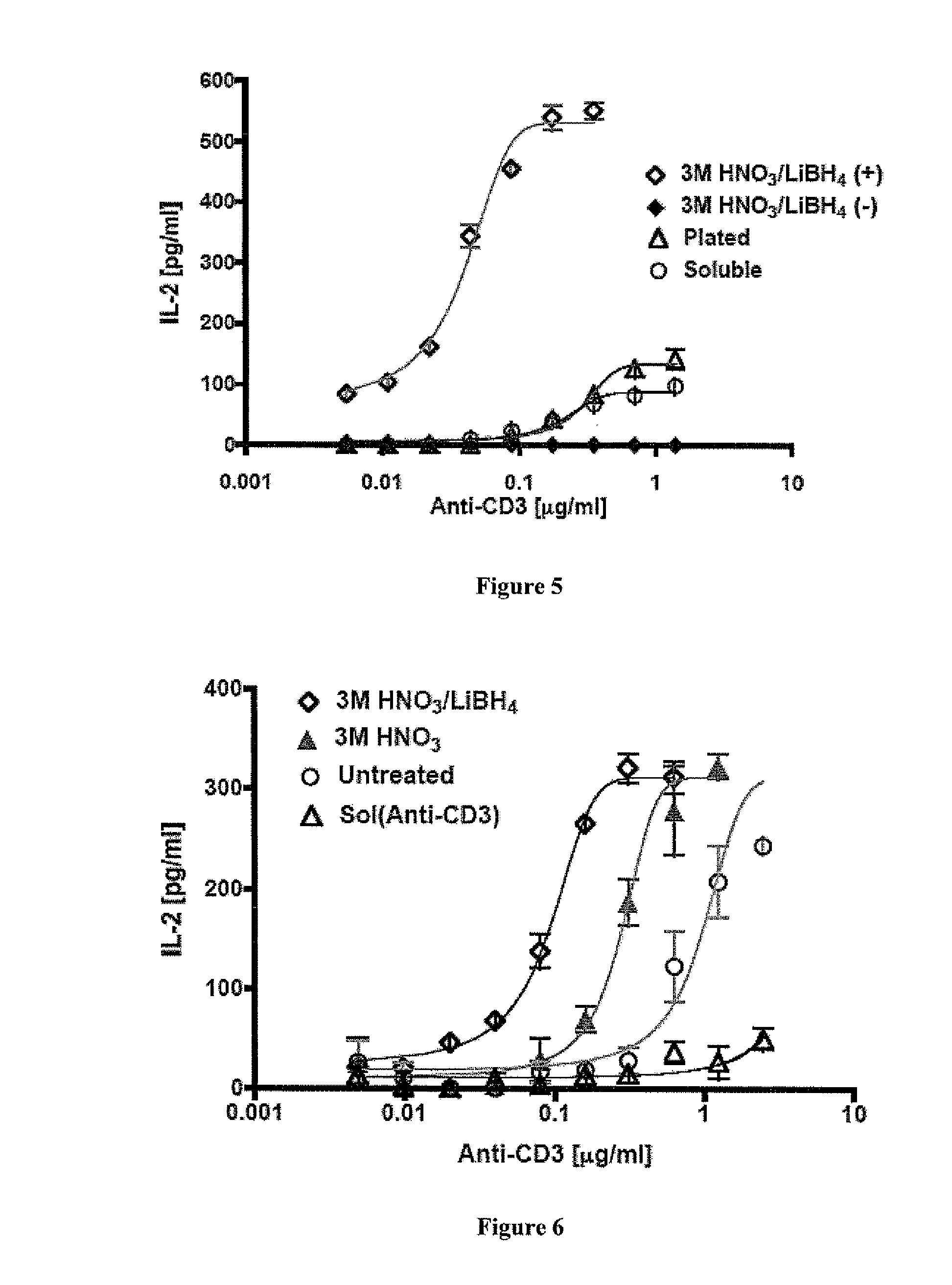Carbon nanotube compositions and methods of use thereof
a technology of carbon nanotubes and compositions, applied in the field of carbon nanotube compositions, can solve the problems of limited malaria and hiv, and many other infectious diseases involving intracellular pathogens, and achieve the limitation of the development of deadly diseases vaccines, and the development of many other infectious diseases
- Summary
- Abstract
- Description
- Claims
- Application Information
AI Technical Summary
Benefits of technology
Problems solved by technology
Method used
Image
Examples
example 1
Effect of Chemical Treatments on Surface Area of SWNTs and Protein Adsorption
[0194]Materials and Methods:
[0195]Materials
[0196]Biotin Anti-CD3 was purchased from BD Biosciences—Phaminogen (San Jose, Calif.). Treated and raw SWNT were obtained from the Department of Chemical Engineering at Yale University.
[0197]Raw SWNT Chemical Treatment
[0198]SWNT bundles were stirred in a 3M HNO3 at 70° C. for 1 hour. The sample was then filtered through a 5 μm pore size PTFE membrane and dried at 45° C. overnight in an oven. Reduced samples entailed the addition of LiBH4 solution in THF (200 mg SWNT+125 ml THF+400 mg LiBH4), then sonication for 1.5 hour. This chemical procedure gives the (3M HNO3 / LiBH4) SWNT group. If the procedure was stopped after the oxidation step (without LiBH4 treatment), the SWNT group is simply called (3M HNO3).
[0199]Determination of Dry SWNT Surface Area
[0200]Dry SWNT (or A.C.) surface area was determined by physisorption of nitrogen using the Brunauer-Emmett-Teller method...
example 2
Cytocompatibility of SWNTs
[0215]Materials and methods were as described above with respect to Example 1, except as noted below.
[0216]Materials and Methods:
[0217]Cytotoxicity Study
[0218]A metabolic assay, Cell Titer Blue (CTB) assay, was used to assess cell viability exposed to SWNT. Each group was cultured in triplicates. A measured amount of sterile SWNT at 2.5 mg / ml was serially diluted in a sterile 96 well U-bottom cell culture plate with RPMI 1640 containing 10% fetal bovine serum (FBS) and 2% penicillin streptomycin (PS). Sodium azide was included as a negative control at an initial volume of 2.5% and was diluted analogously. Hybridoma T cells (B3Z) at a concentration of 4×105 cells / ml were then added uniformly to the assay. The plate was incubated for 24 hours at 37° C. and 5% CO2. Forty microliters of CTB proliferation reagent was added to each well, including the control (no SWNT) then incubation was allowed for 4 more hours at 37° C. and 5% CO2. Cell proliferation was monit...
example 3
Stimulation of T Cells Using SWNTs
[0221]Materials and methods were as described above with respect to Examples 1 and 2, except as noted below.
[0222]Materials and Methods:
[0223]T-Cell Stimulation Using Anti CD3 Loaded SWNT
[0224]The stimulation of T-cells (B3z) was quantified using a mouse IL-2 ELISA. Anti-CD3 and SWNT bundles were mixed overnight at 4° C. on a rotary mixer to allow for physical adsorption of anti-CD3, followed by a washing step to remove unbound anti-CD3. The washed sample was then re-suspended in sterile PBS at the same initial volume. SWNT antibody solution was serially diluted in a microplate followed by the addition of 100 μl of T-Cells (B3z) at 4×105 cells / ml. The cell culture plate was incubated for 24 hrs at 37° C. and 5% CO2. An identical protocol was used for all SWNT groups. For control, soluble and plated anti-CD3, the stimulus was used in similar amounts to anti CD3 loaded SWNT before the wash step. After incubation an ELISA was then performed on IL-2 ext...
PUM
| Property | Measurement | Unit |
|---|---|---|
| concentration | aaaaa | aaaaa |
| pH | aaaaa | aaaaa |
| pH | aaaaa | aaaaa |
Abstract
Description
Claims
Application Information
 Login to View More
Login to View More - R&D
- Intellectual Property
- Life Sciences
- Materials
- Tech Scout
- Unparalleled Data Quality
- Higher Quality Content
- 60% Fewer Hallucinations
Browse by: Latest US Patents, China's latest patents, Technical Efficacy Thesaurus, Application Domain, Technology Topic, Popular Technical Reports.
© 2025 PatSnap. All rights reserved.Legal|Privacy policy|Modern Slavery Act Transparency Statement|Sitemap|About US| Contact US: help@patsnap.com



